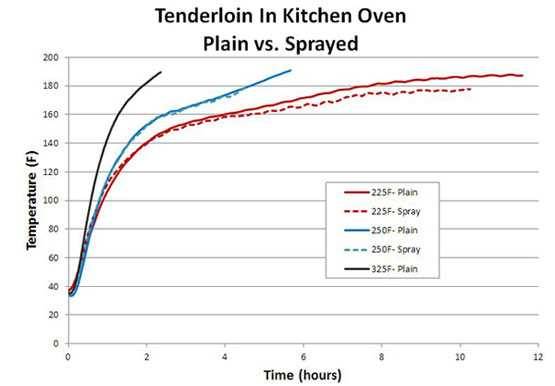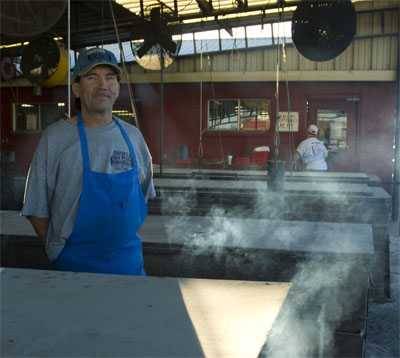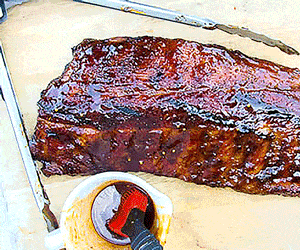Part of the ritual of working the grill is standing with the brush and periodically, like the great artists we are, painting the food with a magical secret liquid.
It allows us to inhale the aromas (ahhh it smells sooooo good), check on the progress (almost done, honey!), look at the hypnotic flames (me like fire!), and act like we know what we are doing.
Hot and fast cooking
When we baste, mop, or spritz, here’s what we are doing:
We are adding flavor. When you first start cooking, bastes don’t penetrate much because the meat is already saturated with moisture. Depending on what is in your mop, some of the flavorings stick to the surface and can build up in layers depending on how long you cook. A thin mop of apple juice, beer, or wine doesn’t have many flavor molecules compared to spices, meat, and sauces, so they add little noticeable flavor. They just moisturize. And most of the liquid just runs off. The flavor molecules in these liquids are few and far between. But if you use a thicker mop, like a Texas mop, there can be some flavor added.
We are removing flavor. One of the problems with basting is that it can wash off spices and marinades. Do it repeatedly, and you can remove a significant amount.
We are reducing shrinkage. Only a little. The AmazingRibs.com science advisor Prof. Greg Blonder says, “Spritzing a fraction of an ounce of liquid onto meat is more or less like spitting into a hurricane. As fast as air travels through a smoker, it can hardly be expected make a dent in the total humidity. And, a water-based spray is more likely to drip off the oily, crispy surface than be absorbed. But it can substitute for moisture from within the meat and slightly reduce shrinkage.”
We are lengthening cooking time. Spritzing, mopping, and basting have little effect on cooking at temps of 250°F and up, or on short cook times to internal temps of, say, 160°F or less, like grilled steaks, burgers, and chicken. On low and slow cooks where the cooker is under 250°F or so, and the meat is cooked to an internal temp of 190°F and up, the extra moisture can add 10 to 20% to the cooking time.
We are softening the crust. As the cooking progresses, the surface dries out and begins to form a crust. That crust turns brown from the Maillard reaction and caramelization, creating wonderful, complex flavors. Crust is good. Basting the dried surface can replace some of the evaporated moisture, but it can also hamper browning and crust formation. That can be bad.
A lot of the flavor of chicken, turkey, and duck is in the fatty skin. The skin is best when dark and crispy. This happens as dry heat drives off moisture in the skin and melts fats. Painting the skin with water-based bastes, even pan drippings or butter (which has water in it), just wets the skin and keeps fowl skin foul and rubbery.
On the other hand, sometimes, painting the skin with oil can help browning and crisping, especially if the cooker is really hot.
We are aiding browning. Mops high in fructose, like apple juice, can caramelize and help brown the surface and add new levels of complexity to the bark.
We are attracting smoke. Smoke is attracted to wet surfaces, and it sticks better to wet surfaces, so when we baste, we make the food more smoky tasting. This phenomenon is discussed in my article on smoke.
We are helping the smoke ring. Although the pink layer of color under the bark is highly prized in low and slow smoked meats, it has no flavor. But by keeping the surface damp, we are allowing sodium nitrite in the smoke to melt on the surface and combine with the myoglobin in the meat to create the smoke ring.
We might be contaminating the meat. Most meat has potentially toxic microbes on its surface. They are killed rapidly on the grill. Most are zapped when the temp gets over 155°F. If you paint the meat with a liquid you used for marinating, the marinade has microbes from the meat. So when we baste or mop, we are putting live microbes back on the surface of the pasteurized meat. They will die pretty quickly if we leave the meat alone under a closed lid for a few minutes, but if the lid is open, or if the meat is removed from the grill soon after basting, we could be serving our guests a tummy ache. Or worse. Click here for more info on food, grill, and knife safety.
Bottom line. The time to baste is after the crust forms, immediately after flipping the meat while the top surface is still hot and bubbly, so the mop can mix with the juices of the meat. While sitting on the surface the water can evaporate, so when you flip again you are not steaming the meat and so the flavor can cook on. If you baste and flip immediately, you are pouring off the flavorings and you can retard the formation of the crust. Basting at this time cools the surface so the meat directly beneath does not overheat and overcook. For more on these processes, read my article on meat science.
Low and slow cooking
When cooking ribs, pork shoulder, brisket, and other low and slow cuts, spritzing with a mister is popular. I asked Blonder to conduct some tests to enlighten us on basting when cooking low and slow.
In previous experiments Blonder explained that moisture evaporating from the surface of meat cooked at low temps, at or below 225°F, cooled the surface so effectively that the meat would heat up to a point somewhere about 150°F in the center, and then it would stop warming for hours. This phenomenon is well known to people cooking beef brisket and pulled pork, and is called “The Stall”. The meat temp stalls, sometimes for many hours, until the surface began to dry out and form a crust called bark, before continuing to cook up to the target temps of 190 to 200°F at which the connective tissues made of collagen combine with moisture in the meat to form gelatin producing the succulent rich flavors prized in pulled pork, ribs, and beef brisket.

Blonder took pork tenderloins and bundled them into 3″ thick cylinders because they are fairly uniform in texture and moisture content. Although they are usually best when cooked to 145°F or so, he used them to test cooking to the higher temp more common for pork shoulder and ribs.
He put one in a kitchen oven and cooked it at 225°F and, with a recording thermocouple digital thermometer, logged its progress. It is the solid red line in the chart at right. As you can see it warmed rapidly to about 140°F and then began to stall as the moisture on the surface began to evaporate and cool the meat the same way sweat cools an athlete.
He then put another section of loin in the oven and quickly opened the door every 30 minutes, spritzed the meat with a mix of apple juice and apple cider vinegar (the dotted red line). In previous experiments on whether opening and closing a smoker will slow cooking, Blonder showed that the impact is minimal on the meat, especially on cookers with a thermostat such as an indoor oven, pellet smokers, or a charcoal grill with a thermostat blower. That’s because meat cooks by the heat built up in the outer layers of the slab being transmitted to the center of the slab, and although opening the cooker cools the air slightly, it has little effect on the meat, and the air rapidly returns to cooking temps.
As you can see, from Blonder’s chart, spritzing had little or no impact on cooling and cooking time needed to hit the optimum temp of 145°F for the tender and lean pork loin. If he took it up to 180°F, a temp more common for pork shoulder, the unspritzed meat hit 180°F in about eight hours (the bumps in the lines are due to the oven cycling on and off in response to its thermostat). Spraying extended the time needed to reach 180°F to nine or 10 hours. A small percentage of that is due to opening the door, but most of it is due to the cooling effect of the mist. Still, the impact on cooking time is not huge, probably about 10 to 20%, adding perhaps one or two hours to the cook.
Then he cranked up the temp and cooked one hunk at 250°F without misting (solid blue line), and one with misting (dashed blue line), and both finished in a dead heat. Notice that they both hit 180°F in about five hours, much faster than when cooked at 225°F. Finally, for the fun of it, he cranked the oven to 325°F and cooked two more loins. You can only see one line in the chart, the black line, because the dashed line is hidden behind it. The results were identical.
Blonder used a kitchen oven because there is much less airflow than an outdoor oven (around five air exchanges per hour). “However,” he explains, “as any athlete knows, evaporative cooling is more effective in a breeze.” Outdoor cookers tend to have a lot more airflow to vent the combustion gases and smoke (more than 100 air exchanges per hour).
This time he placed both hunks of meat into a MAK 1 Star pellet smoker which has a thermostat control. They went in together in order to minimize the differences caused by opening the lid to spritz one. There was no difference in cooking time and weight loss! He explains that “Although high air flow rates rapidly cool, they also dry out the sprayed surface layer just as quickly.”
Tireless and tirelessly curious, the hungry scientist took three small hunks of brisket and coated one with just a barbecue rub, another with a sticky barbecue glaze, and spritzed another. They cooked at 260°F and all three finished in a dead heat (pun intended). Weight loss and tenderness were also similar, with a slight edge to the glazed meat.
What about weight loss? In a similar experiment on chicken thighs, thighs just lightly seasoned with a spice rub lost 33% of their initial weight, while thighs sprayed lost 29%, and thighs with sauce lost only 22%. So the difference between plain and sprayed is minimal and probably not worth the effort. But thighs with a saucy glaze have less loss because the sauce can help seal the moisture in.
What about flavor? Remember, apple juice and vinegar are mostly water. If you mist meat multiple times you are putting down a fraction of a teaspoon of liquid per bite of which flavor molecules are probably less than 2%. The flavor in the meat, in your spice rub, in the smoke, and in the sauce will obliterate the impact of the mist.
Click here to see more complete data on Blonder’s experiments in spraying.



High quality websites are expensive to run. If you help us, we’ll pay you back bigtime with an ad-free experience and a lot of freebies!
Millions come to AmazingRibs.com every month for high quality tested recipes, tips on technique, science, mythbusting, product reviews, and inspiration. But it is expensive to run a website with more than 2,000 pages and we don’t have a big corporate partner to subsidize us.
Our most important source of sustenance is people who join our Pitmaster Club. But please don’t think of it as a donation. Members get MANY great benefits. We block all third-party ads, we give members free ebooks, magazines, interviews, webinars, more recipes, a monthly sweepstakes with prizes worth up to $2,000, discounts on products, and best of all a community of like-minded cooks free of flame wars. Click below to see all the benefits, take a free 30 day trial, and help keep this site alive.
Post comments and questions below
1) Please try the search box at the top of every page before you ask for help.
2) Try to post your question to the appropriate page.
3) Tell us everything we need to know to help such as the type of cooker and thermometer. Dial thermometers are often off by as much as 50°F so if you are not using a good digital thermometer we probably can’t help you with time and temp questions. Please read this article about thermometers.
4) If you are a member of the Pitmaster Club, your comments login is probably different.
5) Posts with links in them may not appear immediately.
Moderators